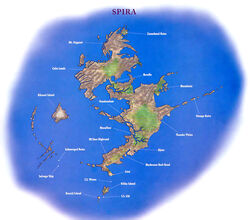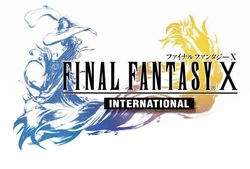Template:Sideicon
Template:Infobox CVG
- This article is about the game. For the information about the game's subseries, see: Final Fantasy X (Series).
Final Fantasy X is the tenth installment in the Final Fantasy series. It follows the story of Tidus and Yuna; and was the first Final Fantasy to appear on a sixth-generation console, namely the PlayStation 2.
Due to Final Fantasy X's success and popularity, it spawned the first-ever direct game sequel to a Final Fantasy game: Final Fantasy X-2, released in 2003-04, which continued the events of Spira two years later through the eyes of Yuna. This came about as the result of an initial concept of spinning off Yuna and Rikku into individual titles of their own, which was later combined into one game.
Final Fantasy X is the first in the series to use full voice acting instead of the previous method of scrolling subtitles. The implementation of voice acting limits the player's ability to change the characters' names and Tidus is the only playable character, apart from aeons, whose name can be changed, and therefore never appears in the scripted dialogue.
A remastered HD version of Final Fantasy X was announced at the Sony Press Conference in Japan on September 14, 2011 as part of a 10th anniversary special, and was released on the PlayStation 3 and PlayStation Vita.[1] The PlayStation 4 version was released in May 2015.[2]
Gameplay
The Sphere Grid
Character growth is undertaken by use of the Sphere Grid. By gaining AP from battles and collecting different types of spheres, characters move through the grid, raising stats and learning abilities.
The sphere grid allows the player to evolve and take on "mixed" abilities, meaning they can learn a wide array of Black Magic, White Magic, Defense and Attack skills. An extra grid was included with the International Version (see below), which has thirty-six fewer nodes, and undefined paths for each character, meaning they can take any role they choose.
Battle System
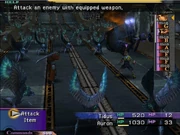
The CTB from Final Fantasy X.
Unlike the past few games where the battle system used ATB, Final Fantasy X uses the Conditional Turn-Based Battle (CTB) system, or the Count Time Battle system in Japan.
Basically, CTB is a turn-based system, which does not operate in rounds; the order of the turns does not guarantee each participant in a battle will have an equal number of turns. Characters with higher speed will be able to take more turns than slower characters, thus making speed more important than in other turn-based battle systems. Furthermore, spells and abilities (such as Haste) can modify the turn order (called the Act List), as some abilities require a longer cooldown time. In general, weaker abilities tend to require less cooldown time, thus introducing a trade-off between speed and power.
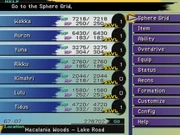
Menu screen.
The battle system is distinguished from the usual flow of the Active Time Battle system by the fact that when a character's turn begins, all action stops while the player decides upon an action. This shifts the focus from reflexes and quick decision-making to strategy and careful planning. Unlike in previous games in the series, the player is able to change characters on the go during battle.
Minigames
- Blitzball - The feature minigame of Final Fantasy X is blitzball, a cross between football (soccer), and water polo, played entirely underwater in a giant sphere pool at Luca. Recruiting players is another big part of blitzball; getting new and better players, and knowing who to cut and when, can be the thing that makes or breaks the team. Blitzball is known throughout the races of Spira as a distraction from the death and destruction that Sin brings.
- Chocobo Racing - Featured less predominantly than in previous games, chocobo training and racing game can be played in the Calm Lands. The player participates in several challenges to train a chocobo and then uses those skills to race another chocobo at Remiem Temple.
- Monster Arena - When fiends from all over Spira are captured using special weapons, they appear in the Monster Arena, also located at the Calm Lands. These fiends can be fought at any time (for a fee), and certain combinations can be bred into tougher enemies.
- Celestial Weapons - Each playable character in the game has their distinctive ultimate weapon, which require some hard work and traveling to acquire.
- Most locations also have smaller minigames, such as the Butterfly Hunt in Macalania Woods, lightning dodging in Thunder Plains and the Valley of the Cactuars in the Bikanel Desert. See each location page for more details.
Setting
Spira is a continent resembling a large island. In terms of climate, Spira ranges from tropical islands (Besaid and Kilika) and a scorching desert (Bikanel Island) to temperate towns (Luca) and the icy Mt. Gagazet. Spira's population is made up of a variety of six races: humans divided into Spirians and the outcast Al Bhed faction, Hypello, Cactuars, Ronso, and Guado.
Characters
Final Fantasy X features seven main playable characters and one temporary guest character.
Main Characters
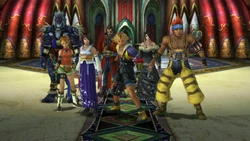
The party of Final Fantasy X.
- Tidus - The main male protagonist, a rising blitzball player who is sent to Spira following the destruction of his hometown, Zanarkand. With seemingly no way of knowing what has happened to him, he becomes guardian to Yuna on her pilgrimage in order to learn about the conflict he has been dragged into. At the start of the game Tidus can be renamed, as no character refers to him by name.
- Yuna - The main female protagonist, a summoner who is on a pilgrimage to defeat Sin, accompanied by her guardians. She is armed with great power and determination as she learns how she can save the tortured world.
- Auron - A mysterious man who watches out for Tidus and Yuna. He has been hailed as a legendary guardian, due to accompanying Braska on his pilgrimage ten years ago. However, his seemingly cynical nature might just hide the truth he witnessed then.
- Kimahri - A Ronso, the only non-human member of the party, who befriended Yuna when she was a child and has guarded her ever since. Though disgraced by his tribe, Kimahri wishes for nothing more than to keep Yuna safe.
- Wakka - One of Yuna's childhood friends from Besaid. As captain of the infamously-pathetic Besaid Aurochs, he has resolved to retire from blitzball and join Yuna on her pilgrimage, bringing along his good-willed cheer.
- Lulu - One of Yuna's childhood friends from Besaid. A black mage who had accompanied summoners on their failed pilgrimages, she is knowledgeable of the world of Spira, and her frequency to scold others only shows how much she is concerned for her companions' safety.
- Rikku - A spunky Al Bhed girl, and the first person Tidus encounters upon arriving in Spira. Though considered a heathen amongst the majority of Spira's population, she only desires to protect Yuna, although her means of doing so sometimes conflict with the goals of the rest of the party.
Guest
- Seymour Guado - A male half-human and half-Guado, Maester of Yevon, and leader of the Guado. Seymour is well-liked by his people and skilled in the art of summoning, but his ideas on what is best for Spira are questionable.
Story
Welcome to Spira

The opening of Final Fantasy X.
Listen to my story. This...may be our last chance.
Tidus's narrative
The party sits around a campfire in silence. Beyond the horizon is a ruined city, covered in pyreflies. Tidus begins to tell his story of how he reached this place.
Tidus's story begins in the metropolis of Zanarkand where he is signing autographs for fans, thinking it is a normal day as the star player for his blitzball team, the Zanarkand Abes. Amid the opening match of the Jecht Memorial Cup (organized to honor Tidus's father, Jecht, who vanished ten years ago), a gigantic wave enters the city destroying everything in its path. The only person undisturbed by this is Auron, a man who has acted as Tidus's mentor since Jecht's disappearance. Tidus meets up with Auron outside the blitzball stadium, but time stops and a boy in purple robes appears before him, and tells him, "It begins. Don't cry."
After the boy vanishes, Tidus continues after Auron who reveals the force destroying the city is called "Sin" and gives Tidus "a gift from Jecht", a longsword. The two fight their way through the invading monsters and when they reach Sin, Auron allows both himself and Tidus to be sucked up into its "maw". Tidus loses consciousness—but not before seeing a brief vision of his father.

Al Bhed salvage crew.
When Tidus awakes he finds himself in a temple ruin where he sets up a camp. When a monster attacks him a group of strange people blow through the door and the leader helps Tidus with the battle. Tidus tries to thank his helpers, but they speak a language foreign to him. The people capture him and bring him to their ship where the group leader, a girl named Rikku, says they are Al Bhed, a faction of people who use the forbidden machina technology.
For Tidus to stay he must accompany Rikku on an underwater salvage operation on an ancient airship. Afterward Tidus tells Rikku about his life in Zanarkand, but Rikku is reluctant to believe him, asking if he breathed in Sin's toxin, which is known to induce amnesia. After Tidus claims he was telling the truth, Rikku decides to take his word, but not before telling him that Sin destroyed Zanarkand a thousand years ago, and since Zanarkand is a holy place it would be wise not to tell any Yevonites about his life there. Shortly after, Sin appears and knocks Tidus off the Salvage Ship.
Tidus wakes up on a sunny beach and is glad to see something familiar: a group of islanders playing blitzball. After showing off his skills the islanders flock around him and the leader of the group, Wakka, explains Tidus has arrived at Besaid Island. He is unnerved when Tidus mentions his home city is Zanarkand and chalks up Tidus's behavior to his recent encounters with Sin. Wakka explains Sin is a monster that rose a thousand years ago, destroying the machina cities, including Zanarkand, as a result of human crimes and use of machina.

Tidus receives Chappu's Brotherhood sword from Wakka.
Wakka leads Tidus to Besaid Village hoping to have him join his blitzball team, the Besaid Aurochs. The team has not won a blitzball game in twenty-three years, and need Tidus's help, even more so since Wakka is planning to leave the team to become a full-time guardian. Tidus agrees to join and later follows Wakka into Besaid Temple, a branch of the Spiran religion of Yevon. The apprentice summoner who had begun her trial in the temple the day before hasn't returned and despite the priest's orders, Tidus goes through the temple's Cloister of Trials to rescue her. Encountering her guardians—the Ronso Kimahri, the black mage Lulu, and Wakka (who'd gone in after him)—Tidus makes it in time to see the summoner, Yuna, exit the Chamber of the Fayth.
Outside, Yuna summons her first aeon, Valefor. Later, Yuna wishes to hear more of Tidus's story and Tidus overhears Lulu berating Wakka over his interest in Tidus, since she believes Wakka is only protecting him out of memories for his deceased brother, Chappu, whose face resembles Tidus's.
The Pilgrimage Begins
The guardians head out with Yuna on her pilgrimage, a sacred journey across Spira to defeat Sin. Wakka takes Tidus along out of hopes somebody will recognize him at the blitz tournament at Luca. They set out on the S.S. Liki to reach Kilika, and Tidus and Yuna get a chance to talk. Yuna believes Tidus's story, partly because ten years ago a man named Jecht worked as her father's guardian. Yuna is the daughter of High Summoner Braska, the last person to destroy Sin. During the journey Sin appears and the party fights it, but fail to stop it from leveling Kilika Village.

Yuna sends the souls of those lost in Kilika.
In Kilika, Yuna performs the sending guiding the souls of the dead to the Farplane. Those who die in Spira can leave behind pyreflies, that, unless sent by a summoner, will become fiends, the primary monsters of Spira. The next day, the group enters Kilika Temple to gain the aeon Ifrit. Though Tidus was to stay out of the Cloister of Trials as he is not yet a guardian, he is tossed in by the guardian of the summoner Dona, who sees Yuna as a rival. Nonetheless, Yuna obtains Ifrit.
The pilgrimage moves to the city of Luca, the second-largest city in Spira, where a blitzball tournament is taking place. Maester Seymour Guado and the elder Grand Maester Yo Mika overlook the tournament, which is being held to honor Mika's 50th year as Grand Maester. During the first match Yuna learns of Auron's presence in Luca and has Tidus and Kimahri help her look for him. While Kimahri's rival Ronso, Biran and Yenke, appear to harass him, Yuna is kidnapped by the Al Bhed Psyches blitzball team to force the Aurochs into surrendering the match. While Wakka handles the game, Tidus goes with Lulu and Kimahri to rescue Yuna from the Al Bhed ship, and Tidus learns Yuna is half-Al Bhed. Lulu sends a signal to Wakka, who wins the game, ending a twenty-three-year losing streak without Tidus's help.
The next blitzball match is against the Spiran champions, the Luca Goers. After the match a group of fiends attacks the stadium. Tidus and Wakka fight the beasts, and are given the surprise aid of Auron. The rest of the fiends are dispatched by Seymour's aeon, Anima, and Yuna is among the spectators left in awe of the aeon's power. Auron explains that Jecht, Braska and him defeated Sin ten years ago and claims that Sin is Jecht. Dumbfounded by this apparent impossibility, Tidus refuses to accept it.
The pilgrimage continues up the Mi'ihen Highroad, now with two new guardians: Auron and Tidus. The party spends the night at Rin's Travel Agency and Yuna tells Tidus about the goal of the pilgrimage: to go to Zanarkand to obtain the Final Aeon, which can destroy Sin. At the highway's north gate the group is not let through because of Operation Mi'ihen, but Seymour gets the Crusaders to let Yuna and the party pass.

Operation Mi'ihen.
The Mushroom Rock Road is under occupation by the Crusaders, the military arm of Yevon's clergy. Under the command of Seymour and his fellow Maester, Auron's former friend Wen Kinoc, the Crusaders join forces with the Al Bhed to defeat Sin. Operation Mi'ihen involves using Sinspawn as bait to draw Sin to Djose, then attack it with a machina said to be as powerful as the aeons. Wakka, being orthodox to Yevon's teachings and resentful of the Al Bhed, is furious over this plan. Auron stands back, knowing the plan will fail. The operation is a disaster: hundreds of Crusaders are killed and Yuna must again perform the sending. Yevon covers its involvement by blaming the defeat on the Crusaders' heresy. Auron explains to Tidus the only reason Sin (Jecht) came to the operation was to see his son.
The party enters the Djose Temple to gain the aeon Ixion where they meet fellow summoner Isaaru. There is a rumor that summoners on pilgrimages are disappearing. The party continues to the Moonflow and while crossing the river on a shoopuf, Wakka points to the sunken ruins of a city as an example of what happens to people who use machina. An Al Bhed abducts Yuna into the water, but she is rescued by Tidus and Wakka who destroy the machina holding her captive. Reaching the other side of the river, they run into Rikku, Yuna's cousin who was the pilot of the destroyed machina. Not wanting to upset Wakka, Tidus and Lulu keep him in the dark about Rikku and Yuna's lineage. Rikku joins the party as Yuna's sixth guardian, with Auron's blessing, who is also aware of her race.
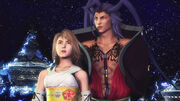
Seymour showing Yuna Zanarkand.
The party moves to Guadosalam, the city of the Guado of which Seymour is the leader. He invites the party to his mansion where he tries to woo Yuna and shows them a sphere recording of what appears to be Tidus's Zanarkand. Within the vision is the first summoner to defeat Sin, Lady Yunalesca, and her husband Lord Zaon. Seymour proposes marriage to Yuna, but she avoids answering and instead takes her group to visit the Farplane, the land of the dead where pyreflies gather to form images of the dead from the visitors' memories.
Rikku believes it to be nothing but an illusion and chooses not to enter. Auron stays behind as well, though he does not give a reason. Inside, Tidus finds Jecht does not appear, meaning he may still be alive as Sin. Tidus accidentally summons the image of his mother, who, as Yuna explains, must have accepted death and entered the Farplane without needing a sending.
Seymour's father, Jyscal Guado, leaves the Farplane as an "unsent", a ghost created from a person who dies "an unclean death". Yuna sends Jyscal and during the ceremony, Auron falls upon his knees, greatly weakened. A sphere appears from the unsent, which Yuna snatches up. While Yuna enters the Guado manor intending to discuss Jyscal, Seymour has already left for Macalania, where the group heads next.
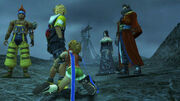
Rikku reveals her fear of lightning.
Rikku panics when the group reaches the Thunder Plains, and halfway across they stay at a Rin's Travel Agency to calm her. Rikku has severe astraphobia—a fear of thunderstorms—left over from a past mishap when her brother aimed a Thunder spell at an attacking fiend, except it missed and hit her instead. While staying at the agency Yuna privately views the contents of Jyscal's sphere. Before the group enters the Macalania Woods Yuna announces she will accept Seymour's offer of matrimony. Auron guesses Yuna is hoping to negotiate something with Seymour, and that she doesn't want the others involved.
The True Face of Yevon
While passing through the Macalania Woods, Auron hacks his way through an overgrown sidepath. Down the path is a spring, the water used to create spheres. After fighting the Spherimorph a movie sphere from Jecht is left behind. The sphere shows snippets of Braska's pilgrimage, and includes a sentimental message from Jecht to Tidus. Auron explains Jecht had accepted his fate to remain in Spira and assist Braska in defeating Sin and later tells Tidus that Jecht loved his son, but didn't know how to express it.
After leaving the woods the group is met by Tromell, Seymour's butler, who leads Yuna into the temple to prepare for the wedding. They are ambushed by Al Bhed with Rikku's brother among them who try to stop the pilgrimage by unleashing the powerful Crawler, which Yuna's guardians destroy. Wakka learns Rikku is an Al Bhed, and expresses his disgust at the "heathen". Angry that no one is taking his side, Wakka heads to Macalania Temple on foot, while the others ride on machina sleds. Depending on the affection levels Tidus will either ride with Rikku, Lulu, Auron, or Kimahri.
If Tidus rides with Rikku, he will learn Rikku and Yuna are cousins, and Rikku explains why the Al Bhed want to protect the summoners during the pilgrimage, disagreeing with the summoners sacrificing themselves to bring happiness to Spira. If he rides with Lulu, Tidus will come to understand Wakka's hatred towards the Al Bhed, which stems from the way Wakka's brother Chappu died: while wielding a forbidden machina weapon of Al Bhed make. He asks Lulu if a human can become Sin and she finally believes Tidus comes from another world.

Seymour confronted the party at Macalania Temple.
At the temple the party comes upon the sphere Yuna had retrieved from the unsent Jyscal, which shows Seymour murdered his father to succeed him as Maester. The party confronts Seymour outside the Chamber of the Fayth and, with the new aeon Shiva, kill him. An angered Tromell appears and takes away Seymour's body before Yuna can send him, and breaks the sphere that proves Seymour's crimes. Now dubbed traitors, the party flees the temple with Guado soldiers in pursuit. They escape when a yeti-like fiend sends them plummeting through the ice of the frozen Lake Macalania.
They land atop a underground mass of land near the bottom of the temple and Yuna reveals that in exchange for marriage, she was hoping to have Seymour turn himself in for his crimes. Auron reminds her the pilgrimage is more important, saying that the fayth are the ones that give power to the summoners, not the temples or the teachings. The ground begins to shake, and the party realizes they had landed atop a docile Sin, which knocks the party unconscious as it begins to stir. Tidus accepts that Sin really is his father.
Awaking on Bikanel Island, Tidus finds himself alone by an oasis. He rounds up his fellow guardians, but cannot find Yuna. Rikku leads the group go to the Al Bhed city of Home, which is under siege by Guado forces. Fighting through the invasion, the party finds the summoners Dona and Isaaru taken by the Al Bhed to the Summoners' Sanctum. Tidus suffers an emotional breakdown after he discovers the truth behind the pilgrimage: summoning the Final Aeon will kill the summoner, and Yuna will meet the same fate if she completes her journey.
The group makes its way to the Al Bhed airship, the Fahrenheit (which was the airship Tidus and Rikku salvaged upon their first meeting), captained by Rikku's father and Yuna's uncle, Cid. The ship takes off with Tidus's group and most of the Al Bhed on board. Cid blows up Home with the airship's missile system to take out the invading forces. The party learns Yuna has been taken by the Guado to the now-unsent Seymour to be married.
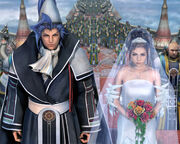
Yuna and Seymour's wedding.
The party finds Yuna at the capital city of Bevelle where she is in a wedding gown to be joined with Seymour. Tidus and his group crash the wedding and force their way through, and Yuna tries to send Seymour. Grand Maester Mika stops her, and Tidus and co. are held at gunpoint by warrior monks and Wen Kinoc. After the ceremony Yuna threatens to dive off the tower if Seymour won't release her guardians. She lets herself fall off the tower, but midair summons Valefor and is safely taken to the Cloister of Trials.
Rikku throws a flash bomb to distract the guards, allowing Yuna's guardians to escape. Along the way to Bevelle's Chamber of the Fayth they discover several machina inside; Auron confirms that this is the "true face of Yevon: they betray their own teachings". Upon arriving at the Chamber Yuna gains the aeon Bahamut, but the group is arrested. Yuna and her guardians are put on trial by the Maesters of Yevon, where they press their case, claiming Seymour should be sent to the Farplane. Grand Maester Mika reveals he is also an unsent and it seems they are without allies except for the Ronso Maester, Kelk Ronso, who leaves Yevon troubled by Jyscal's murder.
While imprisoned Auron tells Tidus about the "spiral of death" that traps Spira: the summoners sacrifice themselves to defeat Sin, but Sin will always return. Yuna and her guardians are deemed traitors and sentenced to the Via Purifico, a dungeon said to be inescapable. At the exit, Yuna is confronted by Isaaru, who places his loyalty to Yevon above his friendship to Yuna. The two duel with their aeons and Isaaru is soundly beaten. Making their way to Bevelle's exit, the party finds Seymour with Kinoc's corpse. Seymour reveals his true plan is to "save" Spira from its cycle of death by becoming Sin and destroying all life. Seymour absorbs the pyreflies from Maester Kinoc's body and transforms into Seymour Natus, but is defeated.
Revelations

Tidus and Yuna together.
Leaving Bevelle for the Macalania Woods, Yuna, her faith in Yevon shaken, goes off into the woods to be alone, but Tidus follows. He finds Yuna in the spring, and reveals he knows the truth behind the Final Summoning and apologizes for talking about life "after" defeating Sin, believing he had only depressed Yuna. Yuna says his words had made her happy. Tidus tries to persuade Yuna to quit the pilgrimage and stay with him, and though tempted, Yuna cannot simply allow Sin to run rampant across Spira. She breaks down in tears and Tidus comforts her, and they embrace and share a kiss under the full moon. They return to the party to continue their journey into the Calm Lands and later to Mt. Gagazet.
Before crossing Gagazet, Kelk and his tribe of Ronso give Yuna their blessing after witnessing her resolve and courage. Tidus and Rikku are intent on finding a way to save her. A pursuing Seymour attacks the Ronso and many are slaughtered, including Kelk, Biran, and Yenke. The party struggles through the frigid mountain before they run into Seymour who transforms into Seymour Flux. Despite Seymour's growing powers, he is again defeated. After the battle, Yuna and the guardians learn of Sin's identity as Jecht.
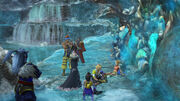
A fountain of fayth lost in dreams.
Near the mountain peak the group comes across a fountain of fayth lost in dreams. Tidus is struck by a dream of his home in Zanarkand and while there, meets the boy in purple robes he saw in the beginning of his journey—the fayth of Bahamut. The fayth reveals Sin was created to leave Spira forever backward so Tidus's Zanarkand could exist eternally without being detected, and that the Zanarkand Tidus hails from is only a dream created by the fayth. Tidus, Jecht, and everybody else from the city are nothing but dreams who will cease to exist once Sin is truly defeated.
As Jecht and Tidus have both been "touched by Sin" they have been made real and have a chance of destroying it. The fayth asks Tidus to defeat Sin so the fayth can be freed of the burden of sustaining "Dream Zanarkand". Tidus accepts, even while knowing doing so will mean he will disappear. After he returns to consciousness, Tidus keeps what he learned to himself.
After passing through Mt. Gagazet the party comes to the original Zanarkand where the pilgrimage is to terminate and Tidus's retelling of the events that led him here ends. The party enters the Zanarkand Ruins where the pyreflies are so numerous they display visions of past summoners who came through to defeat Sin. The party witnesses a vision of a young Seymour, whose mother gave up her life to become the fayth of Anima.
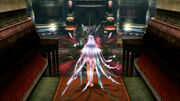
Yunalesca makes her entrance.
They meet Lady Yunalesca in Zanarkand Dome, now an unsent after her battle with Sin a thousand years ago, and learn that to create the Final Aeon a guardian must be sacrificed as its fayth. They glimpse into the past into Braska's pilgrimage where Jecht became the fayth for the Final Aeon. The Final Aeon can only defeat Sin for a short time, for after the old Sin is destroyed the Final Aeon is transformed into a new Sin, and thus whoever becomes the Final Aeon will later become Sin, continuing the spiral of death.
Yuna refuses to partake in what she calls a "false tradition" as she does not wish to sacrifice any of her guardians. Yunalesca believes that without faith in the Final Summoning, and the hope it's meant to bring, Yuna will succumb to despair, and decides to kill her and free her from such a fate. The party sees a vision of young Auron from the past; distraught about Braska's death and Jecht's transformation, Auron went to confront Yunalesca, but was killed, making him an unsent.
In the present time Auron rallies his team to attack Yunalesca. Though Yunalesca is powerful the party prevails and destroys her, forever ending the practice of Final Summoning. Before she fades, Yunalesca mentions that "even if there was another way... even if you did destroy Sin... Yu Yevon the immortal will only create Sin anew".
Defeating Sin
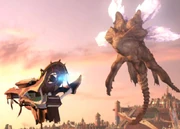
The final battle with Sin.
With Yunalesca gone, the party needs a new way to defeat Sin. Cid arrives in the Fahrenheit to pick them up and they brainstorm a strategy. Yevon is in disarray with the deaths of so many Maesters, and Tidus and his party land in Bevelle during the crisis to confront Yo Mika who learns they have not gained the Final Aeon, and have eliminated it for all eternity. Feeling Spira is doomed to be destroyed by Yu Yevon's spiral of destruction and the despair it engenders, Mika departs for the Farplane.
The party comes up with a plan to beat Sin: they will distract Sin by having all of Spira sing Jecht's favorite song, the "Hymn of the Fayth", and while Sin is subdued, the party will attack on the airship. The attack begins as planned, and eventually the monster opens up its mouth to suck in the airship. Inside Sin they find Seymour and battle him a final time. Despite yet another powerful form, Seymour Omnis, he is defeated. With nowhere for him to run, Yuna sends the rogue Maester. Before disappearing, Seymour says he is glad it was Yuna who would send him, but even if they defeated Sin, Spira's sorrow would continue. At Sin's Core, in a place similar to the blitzball stadium from Dream Zanarkand, Tidus is reunited with his father who only has a short time left before his mind fully becomes Sin's. Jecht turns into Braska's Final Aeon, Sin's true form but the party kills Jecht and saves him from the nightmare of being Sin. Jecht says goodbye to Tidus and scolds him for crying, but the battle is not won yet.
Tidus fades away.
Yu Yevon, requiring an aeon to inhabit, takes over Yuna's aeons one by one. Yu Yevon is an ancient summoner from the Zanarkand of a thousand years ago. When Zanarkand was about to fall to Bevelle Yu Yevon transformed all survivors into fayth and summoned a spectral version of Zanarkand and set it far out to sea to eternally preserve the memory of the city. To protect the summoning he had clad himself in a living armor constructed of pyreflies that became known as Sin and began terrorizing Spira. Yu Yevon lost his humanity and became but a husk that exists only to summon.
The party destroys each aeon as Yu Yevon possesses them, and with nowhere left to hide, Yu Yevon himself appears, revealed to be little more than a floating bug-like creature. The party destroys Yu Yevon, and thus defeats Sin. Auron, his mission complete, requests that Yuna send him. With the fayth retiring from their thousand-year dream, Tidus bids farewell as he fades from existence. Though Yuna tries to stop him from leaving, she falls right through him. Yuna proclaims her love for him (in the original Japanese version, she thanks him instead) and Tidus embraces her. He jumps off the edge of the airship, falling through the clouds, where he sees Braska, Auron, and Jecht waiting for him on the Farplane and high-fives Jecht, symbolizing that he has reconciled with his father.
Epilogue
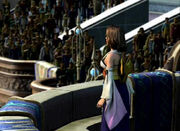
Yuna addresses Spira.
Now a high summoner, Yuna gives a speech at the Luca blitzball stadium about Spira's future: Sin is finally dead, and Spira is theirs again after 1,000 years of terror. The Eternal Calm has begun, and Yuna resolves to aid in the world's reconstruction, and concludes with, "The people and friends that we have lost, and the dreams that have faded... never forget them".
In the depths of the ocean, Tidus wakes up and swims toward the surface with a smile on his face.
Music
Final Fantasy X is the first numbered Final Fantasy game to feature a musical score not completely credited to Nobuo Uematsu, who has written the music for Final Fantasy since its inception. The game's soundtrack was co-scored by Junya Nakano and Masashi Hamauzu.
The game's main theme "Zanarkand" is heard in the beginning and in multiple other forms during the game's main events. Another prominently featured song is the vocal theme "Suteki da ne", played during the romantic scene between Yuna and Tidus at the lake in Macalania Woods. Many tracks also have the instrumental form of this song mixed into them, such as "Yuna's Theme" and "Spira Unplugged".
Other popular songs include "Otherworld", played in the beginning of the game and during the final battle, and the "Hymn of the Fayth", sang in a different way in each temple by each fayth, and by many characters, such as the Al Bhed and even hummed by Tidus.
Development
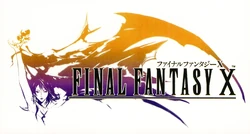
Original logo. Yuna's face is on the left with her right hand raised, and possibly the profile of an aeon or Sin in the background.
Development of Final Fantasy X began in 1999 and was first presented at the 2000 Square Millennium Event together with Final Fantasy IX and Final Fantasy XI, although this early version greatly differs from the final game. Although Hironobu Sakaguchi showed doubts about the transition from 2D to 3D backgrounds, voice acting, and real-time storytelling, he also stated the success of the series was due to constantly changing development and trying out new things. Development for Final Fantasy X cost approximately four billion Japanese yen (approximately 32.3 million dollars) with a crew of more than 100 people, most of whom worked on previous games in the series.
Gameplay
Final Fantasy X was initially going to incorporate online elements, which were later dropped, and added into the next title in the series, Final Fantasy XI. In a beta video shown at the Square Millennium Event in 2000, Tidus has black hair, and the game appears perfectly 3D with the player being able to rotate the camera. Tidus's character model in the demo is more detailed with his clothes and hair bouncing as he moves and also fluttering in the wind. In the menu it was obvious Tidus and Yuna had levels akin to previous Final Fantasy games rather than sphere levels like in the final game.
The Conditional Turn-Based Battle (CTB) was a new battle system replacing the Active-Time Battle (ATB) system from previous titles. The traditional world map concept was dropped, because the developers wanted a more realistic approach, as well as realism of the game's 3D backgrounds and the animation of characters. Originally, Final Fantasy X was going to feature enemies wandering visible on the field map with seamless transition into battles allowing players to move freely around the area during enemy encounters. Battle art director Shintaro Takai has explained the intention was for the battles to come across as a natural part of the story instead of an independent element.
However, due to hardware and system limitations, these ideas were not used until Final Fantasy XI and Final Fantasy XII. Final Fantasy X uses a compromise from the original ideas, with some transitions from the field screen to battle arenas relatively seamless only with the implementation of a motion blur effect. The desire for seamless transitions also led to the implementation of the new summoning system.
The game takes place on a journey from the village of Besaid to Zanarkand with little side-tracking, and to broaden the range of what the players can enjoy many minigames were incorporated. There were close to 10 people handling this aspect, and Yoshinori Kitase left it up to their imagination to come up with ideas.[3]
Voice Acting
Yoshinori Kitase has cited the inclusion of voice acting as one of the big things he wanted to introduce to Final Fantasy when the series moved from PlayStation to PlayStation 2.[4] “As the previous games had only had text, the depth of expression available was broadened by the introduction of voice, but on the other hand, by giving characters actual voices, their facial expressions became more important, and the developers needed to invest more energy into that.[4]
The characters' facial expressions were achieved through motion capture and skeletal animation technology, which allowed animators to create realistic lip movements programmed to match the speech of the game's voice actors. Scenario writer Kazushige Nojima has revealed the inclusion of voice acting enabled him to express emotion more powerfully than before, and he was therefore able to keep the storyline simple. The presence of voice actors led to various changes to the script to match the voice actors' personalities with the characters they were portraying. The inclusion of voice, however, led to difficulties; with the game's cutscenes already programmed around the Japanese voice work, the English localization team faced the difficulty of incorporating the translated script with the rhythm and timing of the characters' lip movements.
The majority of the English dialogue was not based to the actual game footage; the only guidance the voice actors had were samples of the original Japanese dialogue, and they rarely had the opportunity to sync their dialogue with actual footage. Once the voice recording was complete, sound editors would digitally speed up or slow down the audio clips in order to fill the character's allotted speaking time for each particular line.
Storyline
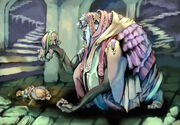
Early concept designs.
The original concept of Final Fantasy X story was that "a person would reach the end of life at 17 years of age". That theme of "inevitable death" was carried over to become Yuna's fate.[3] In Final Fantasy X Ultimania Omega creators' interview, it is mentioned one of the early the premises was having a deadly illness running rampant in the world with Yuna as a nurse following Yevon's teachings treating people while on a pilgrimage. Yevon was a "Red Cross-like organization" with Mika as its chairman. Yuna would have failed to heal the people and it would turn out that the method of treatment itself was leading to the people's deaths.
Kazushige Nojima was initially concerned with establishing a connection between the player and main character and the story was designed so the player's progress through the world and growing knowledge about it is reflected in Tidus's narration. In the early story drafts Tidus's role was vastly different from the final version; Tidus was envisioned as a plumber with the attitude of a delinquent.[5]
The original plans for the game's opening scenario were wildly different from the final version.[5] In the early drafts Tidus would have been swimming around the ocean near Registan (later renamed Zanarkand) to the theme of "Hymn of Fayth", then visiting a place called "Yevon Dome" where Tidus would have met up with his friends, a male and two females. They would have checked the time and thought it was getting late. The Yevon Dome would have been a place where the founder of Registan, Yevon, would have been worshiped, it was a large bowl-shaped arena where Registan's populace would come to meet with friends and offer up their prayers.
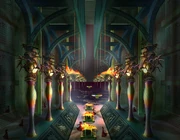
Early concept designs.
The people would have prayed daily to Yevon, but although Yevon would have been deified in Registan, it was not a religion. Tidus would have then descended to the underwater facility of Registan where he would have fought against an underwater boss. Upon leaving the facility Sin would have been seen rising from the ocean and Tidus would have let Sin pass with a smile. The scene would have ended with Tidus glancing at his wristwatch and worrying about it being so late.
Monsters would have begun attacking the city but Auron and the Crimson Blades would have fought them off. Before it was decided Auron would be an unsent, he was envisioned working as a Crimson Blade exterminating monsters in Registan. There were also plans to make Tidus the unsent, but due to the release of the film Sixth Sense with a similar plotline, the storyline was given to Auron instead. There were also plans of having Auron be Jecht in disguise. This way, Jecht could have been watching things all along, but because the developers didn't want Jecht to have a leading part in the game, they gave up on the idea.[6]
Sin was created to be a presence Spirans could simply not avoid, however much they tried. Yoshinori Kitase created him to represent the kinds of calamitous disasters that exist in the real world, such as earthquakes and typhoons. Spira has the teachings of Yevon, which give meaning to people's lives in the face of death, so what Kitase really tried to show in Final Fantasy X was how people behave in the face of unavoidable fate.[4]
The process of acquiring each of the aeons was made an important element to the main story. This importance placed on them made the developers invest in their design. What differentiates Final Fantasy X is the interplay between the summoner and the summoned monster, such as how Yuna will pat Valefor's head during its summoning animation. By emphasizing the relationship between Yuna and the aeons gave the game's final scene where she must part with them even more impact.[4]
Template:Gallery
Leaked Version
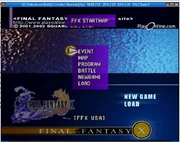
Menu of the preview build of Final Fantasy X.
In May 2009 a preview-build of the North American version of Final Fantasy X was leaked online. This build is from about two months before the final release. It has a debug mode at the main menu, and the FMVs are in Japanese with English subtitles.
Pressing Template:PS Select button during gameplay brings up debug info, and there are plenty of humorous scenes and settings that were never supposed to make it into the final game. The leaked version has greyed out loading options in the config: either "HDD" or "DVD-ROM". There is also an HDD option in the main menu.
Themes
The Final Fantasy series had always had somewhat of a "foreign" feel from the Japanese point of view, the first games taking place in a medieval "European" setting. When the settings moved toward a more modern atmosphere, foreign influence was still strong with Final Fantasy VII originally imagined to take place in the real life New York City, and many locations in Final Fantasy VIII modeled after real world European locations.
Final Fantasy X is a break by being pointedly South East Asian in its feel, most notably with respect to vegetation, topography, architecture and names. Producer Yoshinori Kitase felt that if the setting returned to a medieval European fantasy, it would not help the series advance. While he was brainstorming different world environments, scenario writer Kazushige Nojima suggested a fantasy world that incorporated Asian elements. Many fans had responded negatively to the sci-fi elements of some previous Final Fantasy games, and with Final Fantasy X the developers wanted to expand the fans' definition of the word "fantasy" by taking a different route from the "medieval Europe" fantasy setting so commonly seen in RPGs.[7] A number of the development staff spent time in South East Asia, such as Bali and Thailand, and brought back influences to incorporate into Spira.[8]
For example, Final Fantasy X was the first Final Fantasy game to have its theme song sung in Japanese, and instead of being a pop song, "Suteki da ne" is a traditional Japanese folk song. The intention to capture an Asian feel is also evident in the character designs, with the basis for Yuna's design being that of Okinawan kimonos; the specific type of kimono chosen for her is a furisode. Yuna's dress and necklace are adorned with images of the hibiscus flower also called "yuna", and Tidus's Japanese name (ティーダ) translates to "sun" (太陽) in Okinawan. Japanese influences are also seen in Lulu's hairstyle and Auron's samurai influences. The concepts of aeons, fayth, pyreflies, sending and unsent all harken to Asian legends and traditions.
Yoshinori Kitase has stated the game's main theme is "journey", but that in addition there are many hidden themes.[7] He stated that as a father the theme of family is closest to his heart. Another central theme in Final Fantasy X is legacy, in how both Tidus and Yuna follow in their fathers' footsteps. Tidus had grown up in his father's shadow and becomes a renowned blitzball star like Jecht was. Yuna follows in her father's footsteps by becoming a summoner as he did. Years after Jecht and Braska sacrifice themselves, their children follow the same path but the revelations they uncover along the way force Tidus, Yuna, and their friends to find a new path and free Spira.
Further themed is the Japanese Buddhist religious concepts of jiriki (lit. "self power") and tanriki (lit. "outside power"), said to be the powers that one may choose to follow to become enlightened and ultimately achieve Nirvana once set in a school's teachings. The school of Jodo Shinshu, long empathizing tanriki, sees its historical and cultural influence greatly in the aspects of Yevon; from having a military power, ensuring that the people follow its zeal to have the populace under its teachings, and ultimately, obedient unwavering command, and to bearing influence on political scale, sometimes to the point of corruption.
Another central theme is Gnosticism, a religious movement in the early church that was rejected as a heresy. Gnosticism believes human existence itself to be sinful and that the world has been created by an evil god. The word itself means "knowledge". The Gnostics believed it was this "hidden knowledge" about the world that freed them. Spirans believe Sin is their rightful punishment for their vanity and that because mankind is sinful, Sin is continually reborn. Death is glorified with the summoners sacrificing themselves to summon the Final Aeon, and the aeons themselves being the spirits of the dead. Those who don't find their way to the Farplane become twisted by the envy they feel toward the living and eventually turn into fiends.
The word aeon means "age", "forever" or "for eternity". In Gnostic lore, it denotes the immaterial emanations of God. Yu Yevon can be viewed as the "evil god" from Gnostic lore, known as Yaldabaoth in Gnostic religions, from whom mankind must be saved. Although Yu Yevon isn't a true god in Final Fantasy X, not having created the world and the people, but merely having created Dream Zanarkand and Sin, it is still the god worshiped in the Yevon religion.
Tidus is introduced to the world as someone who can see Spira's ways of life as they really are—false. By getting to know Tidus and believing in his Zanarkand, Yuna comes around to his way of thinking, and at the crucial moment rejects the Final Summoning as a false rite. The Gnostic belief of the "hidden knowledge" about the world being the way to save them, is represented in the game by the discovery of truth behind Sin, Yevon, and the Final Summoning. Once the hidden truth behind Yevon is revealed, Yuna and her friends seek to find a permanent way to vanquish Sin and give the people of Spira a future of independence from Yevon.
Sequels
Final Fantasy X was the first Final Fantasy game to get a direct sequel game, and Final Fantasy X-2 was released two years later, in 2003. Final Fantasy X wasn't originally planned to have a sequel, but after a strong fan reaction to the short story titled "Final Fantasy X: Eternal Calm" included with Final Fantasy X International, the development team decided to continue the story in a sequel.[9]
In an interview in the Final Fantasy X|X-2 HD Ultimania published the same time the Final Fantasy X/X-2 HD Remaster set came out in Japan, 26th December 2013, Kazushige Nojima, the scenario writer for Final Fantasy X and Final Fantasy X-2, hinted at possible future developments for the world of Spira: "If there's enough demand, then we may possibly see new developments. [...] I would personally like to see a sequel like X-3".
Dialogue translated from the Final Fantasy X/X-2 HD Remaster post-credits audio drama, and Nojima's spin-off novella Final Fantasy X-2.5 ~Eien no Daishou~, leave open new plot threads, further hinting at a future sequel, but Square Enix has yet to make any formal announcements on the subject.
Production credits
Staff
| Producer | Yoshinori Kitase |
|---|---|
| Directors | Motomu Toriyama (event), Takayoshi Nakazato (map), Toshirō Tsuchida (battle) |
| Sound Producer & Music | Nobuo Uematsu |
| Main Programmers | Koji Sugimoto (character), Takashi Katano (event) |
| Image Illustrator | Yoshitaka Amano |
| Program Supervisor | Ken Narita |
| Battle Programmer | Masaki Kobayashi |
| Character Designer | Tetsuya Nomura |
| Menu Programmer | Tomonari Ohnishi |
| Art Directors | Yusuke Naora (world), Shintaro Takai (battle) |
| Chief VFX Programmer | Yasunari Ohinishi |
| Real‑Time Graphics Director | Tomohiro Hasegawa |
| Monster Designer | Tetsu Tsukamoto |
| Scenario | Kazushige Nojima |
| Battle Motion Director | Shintaro Tamai |
| Field Programmers | Yukio Ishii, Chikara Yanagimachi |
| Field Motion Director | Go Kikuchi |
| Chief Art Designer | Tetsuya Takahashi |
| 3D Map Director | Yohichi Kubo |
| Lead Battlefield Designer | Tsuyoshi Okahisa |
| Movie Director | Hiroshi Kuwabara |
| Chief Storyboard Designer | Akira Oguro |
| Movie Programmer | Kengo Sasaoka |
| Music | Junya Nakano, Masashi Hamauzu |
| Sound Programmer | Minoru Akao |
| Supervising Dialogue Editor | Teruaki Sugawara |
| Chief Character & Motion Coordinator | Shinji Watanabe |
| Lead Field Designers | Yoshinori Ogura, Takaharu Matsuo, Shinichiro Hamasaka, Masayo Asano |
| Supervising Sound Editors | Eiji Nakamura, Chiharu Minekawa |
| CG Supervisor | Satoshi Tsukamoto |
| Production Executive | Yoichi Wada |
| Square Co., Ltd. | |
| Senior Vice President | Koji Yamashita |
| General Manager | Akira Kashiwagi |
| Localization Directors | Ichiro Nonaka, Kazuyoshi Tashiro |
| SquareSoft Inc. | |
| Localization Manager | Yutaka Sano |
| Senior Vice President | Yuji Shibata |
| Editor | Jennifer L. Mukai |
| Localization Specialists | Brody Phillips, Shigeto Matsushima, Ryosuke Taketomi, Rika Maruya |
Voice Cast
| Character | Japanese | English |
|---|---|---|
| Tidus | Masakazu Morita | James Arnold Taylor |
| Yuna | Mayuko Aoki | Hedy Burress |
| Auron | Hideo Ishikawa | Matt McKenzie |
| Wakka | Kazuya Nakai | John DiMaggio |
| Lulu | Rio Natsuki | Paula Tiso |
| Kimahri Ronso | Katsumi Cho | John DiMaggio |
| Rikku | Marika Matsumoto | Tara Strong |
| Seymour Guado | Junichi Suwabe | Alex Fernandez |
| Jecht | Masuo Amada | Gregg Berger |
| Cid | Koichi Sakaguchi | Micheal McShane |
| Lord Braska | Takuma Suzuki | Andrew Philpot |
| Yo Mika | Hiroshi Iwasaki | Dwight Schultz |
| Wen Kinoc | Hidenari Ugaki | Roger Jackson |
| Kelk Ronso | Koichi Sakaguchi | Corey Burton |
| Luzzu | Ryuzo Ishino | John DeMita |
| Gatta | Hiroshi Kamiya | Adam Paul |
| Lucil | Sayaka Ohara | Candi Milo |
| Elma | Sumomo Momomori | Julia Fletcher |
| Clasko | Takayuki Yamaguchi | Matt Miller |
| Dona | Nanaho Katsuragi | Candi Milo |
| Barthello | Jun Ishimaru | John Demita |
| Isaaru | Akio Suyama | Quinton Flynn |
| Maroda | Masataka Nakai | Robbie Rist |
| Pacce | Motoko Kumai | Candi Milo |
| Belgemine | Kayoko Fujii | Cree Summer |
| Brother | Takayuki Yamaguchi | David Rasner |
| Maechen | Takuma Suzuki | Dwight Schultz |
| Shelinda | Miki Nagasawa | Sherry Lynn |
| Rin | Shunsuke Sakuya | Tom Kenny |
| O'aka XXIII | Hidenari Ugaki | Dwight Schultz |
| Wantz | Takayuki Yamaguchi | Tom Kenny |
| Tromell | Ryuzo Ishino | Corey Burton |
| Zuke | Jun Ishimaru | André Sogliuzzo |
| Bahamut's Fayth | Rio Natsuki | Debi Derryberry |
| Yunalesca | Yōko Koyanagi | Julia Fletcher |
Other Versions
Template:See Also
Final Fantasy X: International
The International Version was released on January 31, 2002, in Japan, and later in Europe (the European release was simply titled "Final Fantasy X"). This updated version of the game has different box art for Japan, and new features, such as an Expert Sphere Grid, which allows for accessing abilities more easily, but less overall stat-growth. New abilities were added to both Standard and Expert Grids.
The Dark Aeons and Penance, all powerful superbosses, were added, as well as many minor changes to dialogue, scenes, the Celestial Weapons' key items (Japan only), characters and armor, weapon customizations, such as Ribbon. The release also includes a bonus disc with behind the scenes making-of features of Final Fantasy X, and a special movie prologue to Final Fantasy X-2.
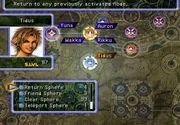
Expert Sphere Grid in the International version.
The European release has the the Dark Aeons and Penance, as well as the new equipment abilities, but didn't change the name of the Celestial Sigils and Crests. As with previous PAL conversions of Final Fantasy installments, the game has noticeable black borders and a slower running-speed as a result of poor PAL conversion. The black label version includes a bonus DVD with the title Beyond Final Fantasy, which includes various interviews with the game developers, as well as two of the English voice actors. Additionally, it also includes trailers of various Square games, an art gallery, short biographies on Nobuo Uematsu and RIKKI, as well as a music video of RIKKI performing the song "Suteki da ne".
Some versions of Final Fantasy X: International have a glitch, whereby if the player goes to the area where they fight Dark Ifrit it is possible to slip past the men blocking the way to Home, and thus, be able to return to the story at the events in Home with Yuna in the party. This glitch can be repeated after the first time it is used.
Final Fantasy X/X-2 HD Remaster
Final Fantasy X was the first Final Fantasy game originally developed for a Sony platform to be remastered. A high-definition port was announced at the Sony Press Conference in Japan on September 14th, 2011 as part of a 10th anniversary special, and was set to be released on the PlayStation 3 and PlayStation Vita. This version is based on the International version, making it the first time the features exclusive to that version will be officially available in North America. The HD remaster has trophies.
On 19 March, 2013, it was confirmed Final Fantasy X-2 was also receiving an HD remastering and that it, too, would be based on the International version of the game. The two games are available together on a single Blu-ray disc for the PlayStation 3 version, but on PlayStation Vita Final Fantasy X-2 is available only digitally, but its code is included in the Final Fantasy X retail version so that the buyer can still get both at once.
It was released in Japan on December 26, 2013 and March 18, 2014 overseas.
Sales and Reception
Final Fantasy X received critical acclaim in the media and enjoyed high sales figures. Within four days of its release in Japan, the game had sold over 1.4 million copies in preorders, which set a record for the fastest-selling console RPG.[10] Since May 2011; the game had sold nearly 8 million copies worldwide.
Final Fantasy X received generally high review scores in both Japanese, western and Middle Eastern media. Critics generally praised the game's storyline, graphics and movies, although some criticized the game's dialogue and linearity, as well as the Sphere Grid leveling system and the fact that cutscenes cannot be skipped. Famitsu readers voted Final Fantasy X the best game of all time in early 2006 and Producer Shinji Hashimoto stated in 2002: "We've had a great reception from the media and already received some awards and so forth, so overall the reaction has been excellent".[11]
On December 3, 2014 Final Fantasy X was voted by the Japanese fans as one of the best five PlayStation games of the brand's 20 years lifespan, along with Final Fantasy VII, Grand Theft Auto V, Metal Gear Solid 3: Snake Eater, and Monster Hunter Freedom Unite.[12]
Packaging Artwork
Template:Gallery
Gallery
Template:See Also Template:Gallery
Allusions
Final Fantasy X contains allusions to previous games and Asian mythologies.
Trivia
- In the game's title logo, the roman numeral 'X' is written in a different typeface to the traditional Runic Font MT used in other logos.
- In the title logo for Final Fantasy X|X-2 HD Remaster, the roman numeral 'X' has been reverted to the Runic Font MT typeface.
- In the background of the initial FMV when Tidus reaches Luca, when the camera pans down a street, the music from "I Want to be Your Canary" from Final Fantasy IX can be heard. Also, during a scene before the street scene (when the camera pans the sides of some buildings), a part of "Rufus' Welcoming Ceremony" from Final Fantasy VII is played.
- There is a subtle reference to Final Fantasy X in Final Fantasy IX through the enemy Ragtime Mouse. On the card it's holding a following question appears: "Pop Quiz! FF10's theme is GUTS! True or false?".
- In a Famitsu popularity poll, four characters from Final Fantasy X (Yuna, Tidus, Auron, Rikku) made the top 50. This is the second most characters from one game, with the most being from Final Fantasy VII.
- Blood is seen in only a few scenes throughout the game: caused by Geosgaeno's attack on a sahagin at Baaj Temple near the beginning of the game, during the underwater scene when Tidus is attacked by Sinscales, running down the left side of the aeon Anima's face from her left eye in the Luca FMV in which she is summoned, on the sand in the aftermath of Operation Mi'ihen, and during the raid on Home.
- During the entirety of Final Fantasy X, Tidus's name is not spoken by the other characters. This was because of a choice of the player to rename the main character.
- Final Fantasy X-2 continues this option despite Tidus being a non-playable character and is referenced as "Star Player of the Zanarkand Abes" in the blitzball minigame.
- Kingdom Hearts breaks this pattern with Wakka speaking Tidus's name during a cutscene. However, Tidus is not a playable character.
- In the poll in which Famitsu asked its readers what games made Japanese gamers cry, Final Fantasy X topped the chart as the number 1 game.[13]
- Final Fantasy X was referenced in the popular sitcom Two and a Half Men. Jake rented the game from a rental store, though later in the episode, when Jake is supposedly playing the game, the music heard is the battle theme from Final Fantasy II.[14]
- Final Fantasy X was referenced in the Thomas Pynchon novel Bleeding Edge with regard to the game's exceptional graphics.
See also
- Final Fantasy X Demo
- Final Fantasy X Allusions
- Final Fantasy X Concept Art
- Final Fantasy X Translations
- Final Fantasy X Timeline
- Final Fantasy X Wallpapers
External links
References
- ↑ http://uk.ps3.ign.com/articles/119/1194253p1.html
- ↑ http://www.jp.square-enix.com/ffx_x-2HD/
- ↑ 3.0 3.1 Final Fantasy X’s Original Idea And Other Reflections From Yoshinori Kitase - Siliconera
- ↑ 4.0 4.1 4.2 4.3 Final Fantasy 10: Kitase reveals the secrets of its success — Gamestm
- ↑ 5.0 5.1 http://www.glitterberri.com/final-fantasy-x/creators-salon/scenario-opening/
- ↑ http://www.glitterberri.com/final-fantasy-x/creators-salon/scenario-auron/
- ↑ 7.0 7.1 "Beyond Final Fantasy" bonus DVD included in the International version of Final Fantasy X
- ↑ Interview with Final Fantasy Director Yoshinori Kitase and Art Director Yusuke Naora — Denkiphile.com
- ↑ Final Fantasy X-2 Developer Interview — IGN
- ↑ Final Fantasy X Sells Like Crazy; World Not Shocked
- ↑ Interview: Square invades London
- ↑ https://www.youtube.com/watch?v=ry1-0XwCAHk
- ↑ http://www.capsulecomputers.com.au/2012/01/famitsu-reveals-games-that-made-the-japanese-cry/
- ↑ http://www.youtube.com/watch?v=Y6-d-YcYJWA
Template:FFX Template:Spira Template:25thcompl Template:Series

